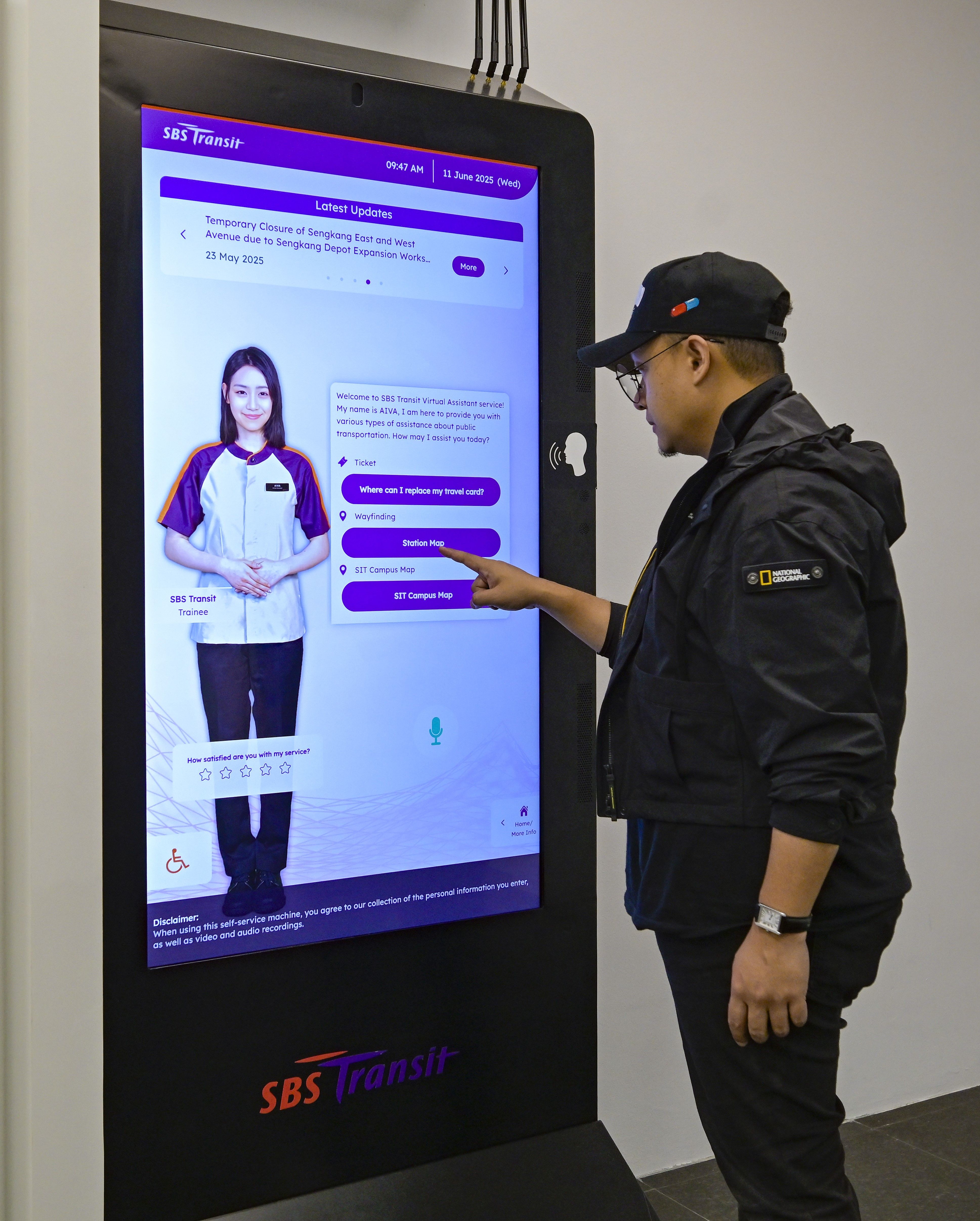Making transportation user-friendly for the hearing impaired
By Amit Roy Choudhury
SBS Transit has developed a kiosk-based GenAI application, SiLViA, to help those who are hard of hearing access information independently at MRT stations, as part of its broader push to utilise AI to make the transportation sector more intelligent.

SiLViA, a kiosk-based AI digital assistant, which provides information to help deaf people travel confidently and independently on their own, is part of SBS Transit’s broader goal of incorporating AI solutions into the transportation sector to not only provide a better travel experience for passengers but also make public transport more accessible for all. Image: SBS Transit.
In this age of digital assistants, it’s no surprise that there are several artificial intelligence (AI) based applications for those who are hard of hearing or deaf.
While these are very helpful for those with a hearing impairment, most are mobile app-based and can only be used for general one-to-one communication.
Understanding the potential of a generative AI (GenAI) to support this group of passengers, Singapore’s bus and train public transport operator SBS Transit, in collaboration with start-up company, FingerDance, has developed a kiosk-based digital assistant, SiLViA, for use at MRT stations and bus interchanges to help deaf people travel confidently and independently on their own.
To subscribe to the GovInsider bulletin, click here.
Speaking to GovInsider, SBS Transit’s Head of Rail Operations and Support, and Head of Customer Experience and Commercial, Shaun Liew, says the AI digital assistant amplifies the human touch by providing real-time communication through sign language, text and audio for commuters, just like a staff member would. It is also capable of translating public announcements at the MRT station into sign language.

SiLViA is part of SBS Transit’s broader goal of incorporating AI solutions into the transportation sector to not only provide a better travel experience for passengers but also make public transport more accessible for all, says Liew.
SBS Transit is Singapore's largest public bus operator and also operates the North East Line, Downtown Line, as well as the Sengkang-Punggol Light Rail Transit (LRT).
SiLViA is currently being tested at the North-East Line Chinatown MRT Station.
Liew says that the GenAI-based SiLViA can interact with users through speech or an on-screen keyboard, which allows them to type queries about wayfinding, station information, and other transit-related questions.
The system has been designed to accurately translate transportation-specific terminology into Singapore sign language with help from the Singapore Association for the Deaf (SADeaf), he adds.
Invaluable help from SADeaf for user testing
Liew notes that beyond linguistic development, SADeaf has helped with user testing by bringing in members of the deaf community to interact with SiLViA during its pilot phase at the Chinatown MRT Station.
“These users provide invaluable feedback that helps refine the system's functionality, ensuring that the digital assistant truly meets the communication needs of deaf commuters.
“Their input has been critical in identifying potential challenges and improving the accuracy and usability of SiLViA's sign language translations,” he adds.
Implementation of SiLViA has been carefully staged, with the six-month pilot at Chinatown Station involving continuous user testing and refinement, he adds.
While it has been trialled at the station, Liew notes that the system is designed with the flexibility to be localised for specific stations and interchanges, which would have different requirements in terms of wayfinding information and train or bus timings.
There are plans to expand the digital assistant to more transport hubs within the next 12 months.
Liew shares that SiLViA's most innovative feature is the ability of AI to convert public announcements at the stations into sign language in real-time, ensuring deaf commuters receive the same critical information as other passengers.
Developing a ‘symbol of hope’
“SBS Transit's broader goal is not to create a perfect technology, but to develop a ‘symbol of hope’ that demonstrates how technology can enable more inclusive transportation experiences.
“The project exemplifies how AI can be used to address specific accessibility challenges, with a focus on community involvement and user-centric design,” he adds.
Complementing SiLViA is AIVA, which is also an AI digital assistant that serves a broader range of commuters, offering general wayfinding information, personalised assistance and support across multiple transportation modes.
AIVA is currently deployed at Punggol Coast Station and Ang Mo Kio Bus Interchange, with expansion plans to more transport hubs.
Liew says that both digital assistants represent SBS Transit's strategic approach to using GenAI to serve different user needs.
“Their development reflects our commitment to open innovation, community co-creation, and using technology to solve real-world transportation challenges,” he adds.
Using AI to inject intelligence into transport network
While SiLViA and AIVA represent the use of AI for customer-facing technologies, SBS Transit is also implementing AI for a more intelligent and safer transport system, says Liew.

Giving an example, he notes that SBS Transit has developed an AI-powered video analytics solution, VAnGuard, to detect rail track intrusions at LRT stations where the tracks are open with half-height platform barriers.
“Utilising intelligent cameras with advanced computer vision capabilities, VAnGuard can detect track intrusions or dangerous behaviour on the platform,” says Liew.
Liew added that the system provides a “proactive approach to safety”.
When a track intrusion is detected, the system immediately alerts the Operations Control Centre, providing a real-time video feed of the incident, he adds.
If the Operations Control Centre assesses a situation as potentially dangerous, it can immediately cut traction power to prevent potential accidents.
By combining AI technology with human intervention, VAnGuard represents a sophisticated approach to preventing accidents and promoting safety in public transportation infrastructure, he adds.
Beyond safety, SBSTransit aims to use AI to enhance operational productivity, optimise transportation networks, and create more responsive public transportation systems.
Our overarching philosophy is to develop a "smarter, greener, more inclusive" transportation infrastructure that uses technology to solve real-world challenges and improve commuter experiences across different abilities and needs, Liew adds.
